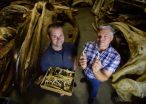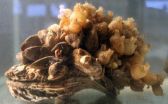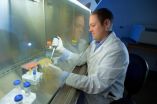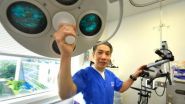(Press-News.org) Both whales and dolphins have pelvic (hip) bones, evolutionary remnants from when their ancestors walked on land more than 40 million years ago. Common wisdom has long held that those bones are simply vestigial, slowly withering away like tailbones on humans.
New research from USC and the Natural History Museum of Los Angeles County (NHM) flies directly in the face of that assumption, finding that not only do those pelvic bones serve a purpose – but their size and possibly shape are influenced by the forces of sexual selection.
"Everyone's always assumed that if you gave whales and dolphins a few more million years of evolution, the pelvic bones would disappear. But it appears that's not the case," said Matthew Dean, assistant professor at the USC Dornsife College of Letters, Arts and Sciences, and co-corresponding author of a paper on the research that was published online by Evolution on Sept. 3.
Dean collaborated with fellow co-corresponding author Jim Dines, Collections Manager of Mammalogy at NHM and one-time a graduate student in Dean's lab, on a painstaking four-year project to analyze cetacean (whale and dolphin) pelvic bones.
The muscles that control a cetacean's penis – which has a high degree of mobility – attach directly to its pelvic bones. As such, it made sense to Dean and Dines that the pelvic bones could affect the level of control over the penis that an individual cetacean has, perhaps offering an evolutionary advantage.
To test this hypothesis, they examined hundreds of pelvic bones – first at the NHM, which has the second-largest collection of marine mammal specimens in North America; and then at the Smithsonian Institution, which has the largest.
"Cetacean skeletons are stored as boxes of bones on warehouse shelves, with each box containing an individual specimen. You have to comb through each box looking for the specific bone you need. The pelvic bones are comparatively small and aren't always collected with the rest of the skeleton, but after the first couple hundred boxes we got very good at finding them when they were present," said Dines, who graduated last spring from USC Dornsife's Integrative and Evolutionary Biology program while maintaining his role at NHM.
Using a 3D laser scanner, they created digital models of the curved bones, offering an unprecedented level of detail about their shape and size, as well as giving them the option to computationally manipulate them – say, to compare two different bones.
Next, they gathered reams of data going as far back as the days of whalers about testis size relative to body mass in whales. Throughout nature, more "promiscuous" animal species – that is, those with females who mate with several males, creating a more competitive mating environment – develop larger testes relative to their body mass as a way of outperforming the competition.
Finally, they compared the size of the pelvic bones (relative to body size) to the size of the animal's testis (again, relative to body size). The results were clear: the bigger the relative testis, the bigger the relative pelvic bone – meaning that more competitive mating environments seem to drive the evolution of larger pelvic bones. Males from more promiscuous species also evolve larger penises, so larger pelvic bones appear necessary to attach larger muscles for penis control.
As a negative control, Dean and Dines also compared testis size to the size of one of the animal's ribs. If pelvic bone size were simply a reflection of overall skeletal size, there should be a corresponding correlation in the ribs – but there was not, strengthening the interpretation that whale pelvic bones are specifically targeted by selection related to mating system.
"Our research really changes the way we think about the evolution of whale pelvic bones in particular, but more generally about structures we call 'vestigial.' As a parallel, we are now learning that our appendix is actually quite important in several immune processes, not a functionally useless structure," Dean said.
Over the course of their four-year project, the team created a new way of measuring and quantifying the complicated 3D structures of bones, using laser scanners to generate 3D images of the bones and developing novel computational methods to analyze bones that lack obvious landmarks.
The process has significant potential for the recording and study of bones by museums, Dines said.
When doing their data collection, the team had to request loans from the Smithsonian and several other museums, which would ship out the bones themselves for study. However, if all specimens were recorded using Dean and Dines' system, digital copies could be sent anywhere in the world for free – without risking the loss or damage of the original specimen. The data that Dean and Dines collected are detailed enough to generate 3D printed versions of the bones, if desired.
"Cutting edge imaging technologies like 3D laser scanning are revolutionizing how museum collections are used. Not only do they give us a new way of analyzing bones and other specimens, they also allow us to make precise replicas of those specimens. The replicas can then, for example, be sent to colleagues abroad or placed on exhibit while the original specimen stays in the museum researcher's lab for further study," Dines said.
Their collaborators in this effort included Peter Ralph and Andrew Smith of USC Dornsife; E. Otarola-Castillo of Harvard University and Iowa State University; and Jesse Alas of West Adams Preparatory High School.
High school students are rarely listed as co-authors on peer-reviewed scientific journal articles, but Alas more than earned his place on the list, Dean said.
Currently a student at UC Irvine, Alas crossed Dean's path by chance when, on a tour of USC with other local high schoolers, he spotted a bit of Python programming language that Dean had written on a white board for his undergraduate students. Dean said, "when I asked where he learned it, it turned out he was self-taught."
Dean hired Alas to navigate much of the complicated computation that encoded 3D data of the pelvic bone structure.
INFORMATION:
This research was funded by USC startup funds, the National Institutes of Health (grant #1R01GM098536), and the William Cheney, Jr. Memorial Fund for Mammalogy.
Whale sex: It's all in the hips
New research turns a long-accepted evolutionary assumption on its head -- finding that far from being just vestigial, whale pelvic bones play a key role in reproduction
2014-09-08
ELSE PRESS RELEASES FROM THIS DATE:
Study puts some mussels into Bay restoration
2014-09-08
Restoring oysters—and their ability to filter large volumes of water—is widely seen as a key way to improve the health of Chesapeake Bay. New research makes this calculus even more appealing, showing that the mussels that typically colonize the nooks and crannies of a restored oyster reef can more than double its overall filtration capacity.
The study—by researchers at the University of Maryland, the Smithsonian Environmental Research Center, and the Virginia Institute of Marine Science—appears as the cover story in the most recent issue of Restoration Ecology.
"Many ...
New targets for treating pulmonary hypertension found
2014-09-08
Two new potential therapeutic targets for the treatment of pulmonary arterial hypertension, a deadly disease marked by high blood pressure in the lungs, have been identified by researchers at the University of Illinois at Chicago. Their findings are reported in the American Journal of Respiratory and Critical Care Medicine.
Early symptoms of pulmonary arterial hypertension include shortness of breath and exercise intolerance. As the disease progresses, patients may require oxygen supplementation and lung transplantation. Heart failure can develop and is a major cause of ...
New compound inhibits enzyme crucial to MERS and SARS viruses, with a catch
2014-09-08
Scientists at the University of Illinois, Chicago, have identified a compound that effectively inhibits an enzyme crucial to the viruses that cause Middle East respiratory syndrome (MERS) and severe acute respiratory syndrome (SARS). The compound appears to have a different method of inhibition in each virus due to slight differences in each virus' enzyme which means finding other compounds that inhibit both may be difficult according to research presented at the 54th Interscience Conference on Antimicrobial Agents and Chemotherapy (ICAAC) an infectious disease meeting ...
How quickly viruses can contaminate buildings and how to stop them
2014-09-08
Using tracer viruses, researchers found that contamination of just a single doorknob or table top results in the spread of viruses throughout office buildings, hotels, and health care facilities. Within 2 to 4 hours, the virus could be detected on 40 to 60 percent of workers and visitors in the facilities and commonly touched objects, according to research presented at the 54th Interscience Conference on Antimicrobial Agents and Chemotherapy (ICAAC), an infectious disease meeting of the American Society for Microbiology.
There is a simple solution, though, says Charles ...
A low-energy optical circuit for a new era of technology
2014-09-08
Unlike electronic circuits, optical, or "photonic", circuits work with light rather than electricity, which makes them 10 to 100 times faster. They are also more energy-efficient because they show lower heat loss, better signal-to-noise ratios and are less susceptible to interference. Used especially for communications (e.g. fiber optics), optical circuits may use tiny optical cavities as 'switches' that can block or allow the flow of light, similarly to transistors in electronics. EPFL scientists have now fabricated and experimentally tested a silicon-based 'photonic crystal ...
To admit or not to admit: Variation in hospitalizations from ER costs billions
2014-09-08
ANN ARBOR, Mich. — It sounds like the setup for a joke: Two identical patients go to two different hospital emergency entrances, complaining of the same symptoms.
But what happens next is no laughing matter, according to a new University of Michigan study published in the September issue of Health Affairs. While one patient may get treated and released from the emergency department, the other gets sent upstairs to a hospital bed – at a cost of tens of thousands of dollars.
In fact, doctors at one hospital may be as much as six times as likely to admit an emergency ...
Scientists reveal cell secret potentially useful for vaccines
2014-09-08
The best defense is a good offense, especially when it comes to the immune system. The troops that respond to an infection are split into two squadrons, and, until recently, it seemed that the two were independent, without much interaction.
Now, in a paper published this week in Nature Immunology, a team of scientists from the Virginia Tech Carilion Research Institute and the University of Alabama at Birmingham say that the immunology boot camp is more communication-intensive than initially thought — a discovery that could help efforts to produce more effective vaccines.
"We ...
Women and health professionals spark new cycle of improving maternal and newborn health
2014-09-08
Demand for better care by women linked with the expansion of basic services, rather than political pressure, has helped to improve midwifery services in low to middle-income countries, according to international research involving the University of Southampton.
An examination of maternal and newborn health systems for the Lancet Series on Midwifery found that after initial investment in maternal and newborn health infrastructure, a virtuous cycle developed in these countries – with increased demand for care leading to the deployment of more midwives, better services, ...
Facial plastic surgery can safely address the major aspects of aging in 1 operation
2014-09-08
AUGUSTA, Ga. – A total facial rejuvenation that combines three procedures to address the multiple signs of an aging face and neck can be performed safely at one time, a new study shows.
Total facial rejuvenation, which combines an extensive facelift to tighten skin and muscle; specialized, midface implants to restore fullness; and laser resurfacing to reduce skin's irregular texture and discoloration, can be safely performed at one time, reports Dr. Achih H. Chen, facial plastic surgeon.
Chen, Director of Facial Plastic and Reconstructive Surgery at the Medical ...
Enigmatic Viking fortress discovered in Denmark
2014-09-08
It is the first time for over 60 years that a new Viking fortress is found in Denmark, says curator Nanna Holm of The Danish Castle Centre. Søren Sindbæk, professor of medieval archeology at Aarhus University, explains: "The Vikings have a reputation as a berserker and pirates. It comes as a surprise to many that they were also capable of building magnificent fortresses. The discovery of the new Viking fortress is a unique opportunity to gain new knowledge about Viking war and conflicts, and we get a new chance to examine the Vikings' most famous monuments. " The previously ...
LAST 30 PRESS RELEASES:
Numbers in our sights affect how we perceive space
SIMJ announces global collaborative book project in commemoration of its 75th anniversary
Air pollution exposure and birth weight
Obstructive sleep apnea risk and mental health conditions among older adults
How talking slows eye movements behind the wheel
The Ceramic Society of Japan’s Oxoate Ceramics Research Association launches new international book project
Heart-brain connection: international study reveals the role of the vagus nerve in keeping the heart young
Researchers identify Rb1 as a predictive biomarker for a new therapeutic strategy in some breast cancers
Survey reveals ethical gaps slowing AI adoption in pediatric surgery
Stimulant ADHD medications work differently than thought
AI overestimates how smart people are, according to HSE economists
HSE researchers create genome-wide map of quadruplexes
Scientists boost cell "powerhouses" to burn more calories
Automatic label checking: The missing step in making reliable medical AI
Low daily alcohol intake linked to 50% heightened mouth cancer risk in India
American Meteorological Society announces Rick Spinrad as 2026 President-Elect
Biomass-based carbon capture spotlighted in newly released global climate webinar recording
Illuminating invisible nano pollutants: advanced bioimaging tracks the full journey of emerging nanoscale contaminants in living systems
How does age affect recovery from spinal cord injury?
Novel AI tool offers prognosis for patients with head and neck cancer
Fathers’ microplastic exposure tied to their children’s metabolic problems
Research validates laboratory model for studying high-grade serous ovarian cancer
SIR 2026 delivers transformative breakthroughs in minimally invasive medicine to improve patient care
Stem Cell Reports most downloaded papers of 2025 highlight the breadth and impact of stem cell research
Oxford-led study estimates NHS spends around 3% of its primary and secondary care budget on the health impacts of heat and cold in England
A researcher’s long quest leads to a smart composite breakthrough
Urban wild bees act as “microbial sensors” of city health.
New study finds where you live affects recovery after a hip fracture
Forecasting the impact of fully automated vehicle adoption on US road traffic injuries
Alcohol-related hospitalizations from 2016 to 2022
[Press-News.org] Whale sex: It's all in the hipsNew research turns a long-accepted evolutionary assumption on its head -- finding that far from being just vestigial, whale pelvic bones play a key role in reproduction





